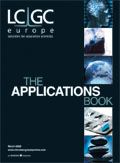Trace Level Analysis of Melamine in Milk Products on 7890A/5975C Using a New Agilent J&W DB-5ms Ultra Inert Column and SamliQ SCX Cartridges
GC–MS method is presented for the quantitative determination and confirmation of melamine residues in milk products. The milk sample was cleaned up using Agilent's SampliQ SCX SPE cartridges before derivatization. The derived extracts were analysed by GC–MS with EI in synchronous SIM/scan mode on a Agilent J&W DB-5ms Ultra Inert column.
Yun Zou and Min Cai, Agilent Technologies (Shanghai) Co. Ltd, Shanghai, China.
Melamine is an organic base chemical most commonly found in the form of white crystals rich in nitrogen. Recently, melamine adulterated in milk product has attracted much attention all over the world. A screening method using GC–MS for both melamine and cyanuric acid was published by the US FDA,1 the detection limit for GC–MS screening method is 10 μg/g. It cannot meet the requirement of many regulations for determination of melamine at trace level (i.e., less than 0.05 μg/g)2 .
In this work, a sensitive GC–MS method was developed using Agilent SampliQ SCX and Agilent J&W DB-5ms Ultra Inert column. The LOD of the method is 0.0025 μg/g.

Figure 1
Experimental
Sample preparation
A 5.0 g milk powder is extracted with 40 mL 1% trichloroacetic acid solution by ultrasonic for 15 min; 2 mL of 22 g/L lead acetate is added before diluting the extract with 1% trichloroacetic acid solution to 50 mL. After centrifugation, a 5 mL aliquot of the supernatant is collected for SPE clean-up.
SPE procedure
1. Condition the cartridge (SampliQ SCX, 60 mg, 3 mL) with 3 mL methanol and 5 mL water.
2. Load 5 mL sample.
3. Wash cartridge with 3 mL water and 3 mL methanol.
4. Elute cartridge with 3 mL of 5% ammonium hydroxide in methanol.
5. Evaporate solvent.
6. Derivatize the extract with 600 μL pyridine and 200 μL BSTFA, and incubate at 70 °C for 30 min.

Results and Discussion
As demonstrated here, SPE protocols were used to prepare milk samples for analysis. Compared with FDA method, the SampliQ SCX SPE cartridge effectively removed interferences from the sample matrix. Meanwhile, the new Agilent J&W Ultra Inert column provided better sensitivity and peak shape for active compounds and then achieved reliable results for trace level analysis.3
The method has a good linearity in the range from 0.025 to 2.000 μg/mL with r2 of 0.9986. The average recoveries of melamine, for milk spiked at 0.080, 0.800, 1.600 mg/kg, were over 80% with RSD lower than 5%. The LOD is 0.0025 mg/kg in the milk matrix.
The results obtained from this study indicate this SPE-GC–MS method is suitable for trace level analysis of melamine in milk products.
References
1. US Food and Drug Administration, GC–MS Screen for the Presence of Melamine and Cyanuric Acid, Revised April 25 (2007).
2. China GB/T 22388-2008 Determination of melamine in raw milk and diary products.
3. "Agilent J&W Ultra Inert GC Columns: A New Tool to Battle Challenging Active Analytes," application note 5989-8685EN, May 29 (2008).
4. Yun Zou and Min Cai, "Trace-Level Analysis of Melamine in Milk Products on Agilent 7890A/5975C GC/MSD Using a New Agilent J&W DB-5ms Ultra Inert Column and SampliQ SCX Cartridges", application note 5990-3282EN.

Agilent Technologies, Inc.
2850 Centerville Road, Wilmington Delaware 19808, USA
tel. +1 800 227 9770 fax +1 302 633 8901
E-mail: info_agilent@agilent.com
Website: www.agilent.com/chem

Study Examines Impact of Zwitterionic Liquid Structures on Volatile Carboxylic Acid Separation in GC
March 28th 2025Iowa State University researchers evaluated imidazolium-based ZILs with sulfonate and triflimide anions to understand the influence of ZILs’ chemical structures on polar analyte separation.
Quantifying Microplastics in Meconium Samples Using Pyrolysis–GC-MS
March 26th 2025Using pyrolysis-gas chromatography and mass spectrometry, scientists from Fudan University and the Putuo District Center for Disease Control and Prevention detected and quantified microplastics in newborn stool samples.










